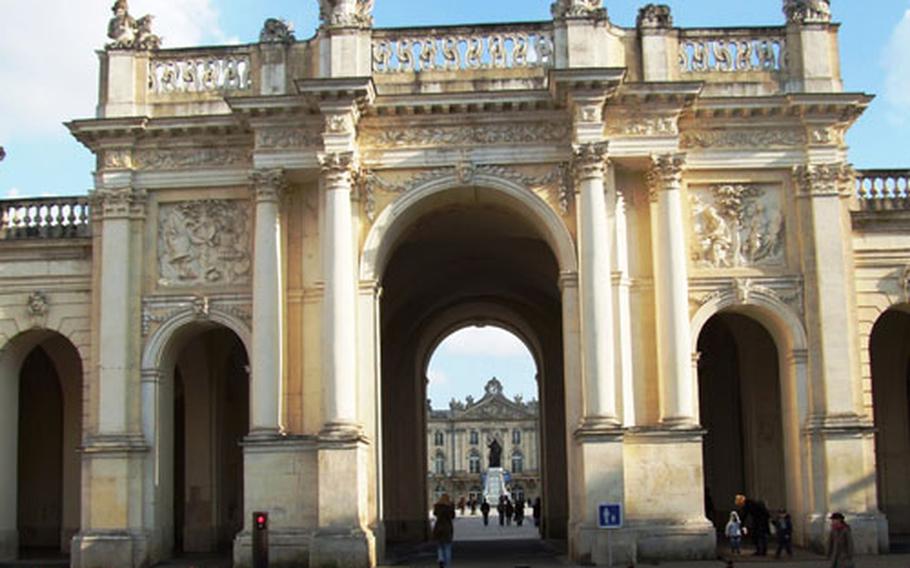
The Triumphal Arch leading to the Place Stanislas in Nancy is copied from an arch in Rome and dedicated to the glory of Louis XV. (Leah Larkin / Special to Stripes)
Place Stanislas in Nancy is considered one of the most beautiful squares in the world. It is a gem of rococo décor with gilded wrought-iron gates and lavish fountains. In the center of the huge rectangle is the solitary statue of its namesake — the portly Stanislas. Classical buildings and cafes with outdoor tables complete the splendid setting.
Stanislas Leszczynski, the dethroned king of Poland, was the father-in-law of Louis XV and the last of the independent dukes of Lorraine. His urban renewal plan for Nancy, carried out in the mid-18th century, transformed the city into one of France’s most attractive towns.
In 2005, Place Stanislas was restored and cars were banned. Together with two adjacent squares, the Place d’Alliance and the Place de la Carrière, it has been declared a UNESCO World Heritage Site.
In the late 1800s, many years after Stanislas, Nancy became known for a different art style: art nouveau. Emile Gallé, a furniture maker and glass master, promoted a new style inspired by nature. Young artists and cabinet makers followed his example and founded the School of Nancy — École de Nancy — in 1901.
To see a remarkable collection of their decorative objects and furniture, visit the Musée de l’École de Nancy housed in the 1909 mansion of Eugene Corbin, a local businessman who supported art nouveau. The city’s Fine Arts Museum — La Musée des Beaux-Arts de Nancy — has, in addition to works by 19th- and 20th-century artists and a painting by Rubens, an art nouveau collection of more than 600 works of Daum glass. It illustrates the history of Daum, a company that was active in the School of Nancy and is still producing glass creations. If you crave a piece of contemporary Daum glass, visit the company’s boutique museum on Place Stanislas.
Wherever you walk in Nancy, you’re likely to see art nouveau — be it a bank, a pharmacy or an apartment building with curvy, often colorful décor. Pick up the brochure, "Art Nouveau, the Itineraries," at the tourist office in Place Stanislas with a map and list of the major attractions.
For a real feast of color, head to the indoor market hall with its mouthwatering displays of fruits and vegetables. If all that food makes you hungry, stop in a nearby bakery and purchase some macaroons. This Nancy specialty was invented in 1793 by two Benedictine nuns, the "Sisters Macaroon."
If you go ...
• Hôtel de Guise, a centrally located hotel, has rooms from 64 euros; breakfast, 8 euros. 18 rue de Guise; (+33) (0) 383-32-24-68, www.hoteldeguise.com.
• Brasserie Flo-L’Excelsior, 50 rue Henri Poincaré, is a Nancy institution famous for its art nouveau décor as well as its food; a three-course lunch menu costs 22.90 euros. (+33) (0) 383-35-24-57, www.brasserie-excelsior.com
• Restaurant L’Arsenal, 24 place de l’Arsenal, is a trendy eatery offering excellent food with three-course menus for 30 euros. (+33) (0) 383-32-11-01
• Musée de l’École de Nancy, (School of Nancy Museum), 36-38 rue du Sergent Blandan, is open 10:30 a.m. to 6 p.m. Wednesday through Sunday; admission 6 euros.
• Musée des Beaux Arts (Fine Arts Museum), 3 Place Stanislas, is open 10 a.m. to 6 p.m. daily except Tuesday; admission 6 euros.
• More information on the city: www.ot-nancy.fr.
— Leah Larkin